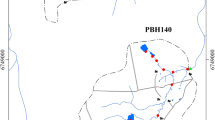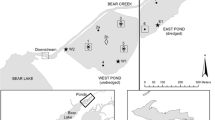Abstract
We chose two surface soils with contrasting textures as model sediments for a model pond study. One soil, a calcareous clay, had a relatively high natural phosphate content and a large phosphate adsorption capacity. The second soil, a non calcareous loam, had a relatively low natural phosphate content and a small phosphate adsorption capacity. Chemical characteristics of both soils were roughly proportional to mineral surface area.
Pasture sites of each soil were tilled to a depth of 15 cm and two plots at each site were fertilized by hand with triple superphosphate. A third plot at each site was left unfertilized. After fertilization the plots were mechanically mixed and left fallow for 2 to 3 months. Then the plots were resampled and equilibration phosphate concentrations were determined again. Results showed significant phosphate fixation by the clay soil but no fixation by the loam soil.
Similar content being viewed by others
References
Allison, L. E. 1965. Chapter 90 Organic carbon. In: Methods of Soil Analysis: Chemical and Microbiological Properties. Agron. No. 9: Part 2. C. A. Black, Ed. in Chief. Amer. Soc. Agron., pub. p. 1367–1394.
Allison, L. E. & Moodie, C. D. 1965. Chapter 91 Carbonate. In: Methods of Soil Analysis: Chemical and Microbiological Properties. Agron. No. 9: Part 2. C. A. Black, Ed. in Chief, Amer. Soc. Agron., pub. p. 1379–1395.
Day, Paul R. 1965. Chapter 43. Particle fractionation and particle size analysis. In: Methods of Soil Analysis: Physical and Mineralogical Properties. Including Statistics of Measurements and Sampling. Agron. No. 9: Part I C. A. Black. Ed. in Chief. Amer. Soc. Agron., pub. p. 545–566.
Golterman, H. L. & Clymo, R. S. 1969. Methods for chemical analysis of fresh waters. Int. Biol. Programme. Blackw ell Scientific Int. Biol. Programme. Blackwell Scientific Publ., Oxford, England. 166 p.
Mehta, N. C., Legg, J. O., Goring, C. A. I. & Black, C. A. 1954. Determination of organic phosphorus in soils: I. Extraction method. Soil Sci. Soc. Proc. 18: 443–449.
Olness, Alan, Troeger, W. W., Huckleberry, R. R. & Pardue, G. D. 1978. Phosphorus in a model pond study: II. Sediment fertility and water concentrations, 63, 3: 99–104 Hydrobiologia.
Peech, Michael. 1965. Chapter 60 Hydrogen-Ion Activity. In: Methods of Soil Analysis: Chemical and Microbiological Properties. Agron. No. 9: Part 2. C. A. Black, Ed. in Chief, Amer. Soc. Agron., pub. p. 914–925.
Ryden, J. C., Syers, J. K. & Harris, R.F. 1973. Phosphorus in runoff and streams. Advan. Agron. 24: 1–45.
White, R. W. & Beckett, P. H. T. 1964. Studies on the phosphate potentials of soils. Part I. The measurements of phosphate potential. Plant Soil 20: 1–15.
Additional information
Research Soil Scientist, Botanist, Physical Science Technician and Physical Science Technician, respectively, USDA-ARS Agric. Water Quality Management Lab.
Contribution from the USDA-ARS agricultural Water Quality Management Lab., Durant, OK 74701.
Rights and permissions
About this article
Cite this article
Olness, A., Troeger, W.W., Pardue, G.D. et al. Phosphorus in a model pond study: I sediment selection and preparation. Hydrobiologia 63, 11–15 (1979). https://doi.org/10.1007/BF00021012
Received:
Published:
Issue Date:
DOI: https://doi.org/10.1007/BF00021012




